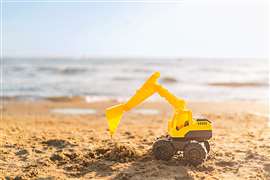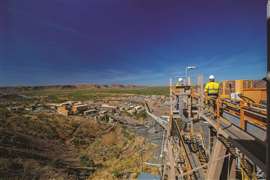Read this article in 中文 Français Deutsch Italiano Português Español
Yellow Line: Is construction equipment changing colour?
09 May 2024
From Blippi’s Excavator Song to Scoop from Bob the Builder, yellow construction machines have won a place in popular culture. But, with more and more construction equipment manufacturers trying to distinguish themselves in an increasingly crowded marketplace, it seems as if the ubiquitous yellow equipment found on construction sites is being eroded by a rainbow of global brands. Lucy Barnard reports.
Construction equipment rarely makes much of an impact on the coveted pop singles chart. But back in 2005, a song about a boy on an excavator by folk due Nizlopi outsold Westlife and Diana Ross and only narrowly lost out to the winner of TV music talent show The X Factor on becoming UK Christmas Number One.
“And we’re like giants up here in our big yellow digger/ Like zoids, or transformers, or maybe even bigger,” crooned singer Luke Concannon in the hit, known simply as The JCB Song.
Certainly, from Blippi’s Excavator Song to Scoop from Bob the Builder, yellow construction machines have won a place in popular culture. A search on Amazon for yellow excavators brought up 725 results, while their red and orange equivalents produced less than half that number.
 A typical toy yellow excavator on a beach. Photo: Adobe Stock
A typical toy yellow excavator on a beach. Photo: Adobe Stock
But, with more and more construction equipment manufacturers trying to distinguish themselves in an increasingly crowded marketplace, it seems as if the ubiquitous yellow equipment found on construction sites is being eroded by a rainbow of global brands.
A broad brush analysis of KHL Yellow Table listing the top 50 global construction machinery manufacturers, shows that in 2021, 85.1% of sales for companies manufacturing excavators were accounted for by companies known for their yellow liveries. By 2022, the proportion of sales to yellow excavator companies had fallen to 76.2% and by 2023 it had fallen again to 71.5%.
According to the tables, the increase in the proportion of alternatively coloured construction equipment can be put down to the decisions by some manufacturers to rebrand to alternative fleet colours as well as an increase in sales from some OEMs which traditionally manufacture in alternative colours.
In 2020, Japanese giant Yanmar, known by many as the grandmother of compact construction equipment, announced that its 4-tonne SV40 ultra tight tailswing mini excavator and all other subsequent machines would come in a new ‘premium red’ rather than the traditional yellow it had been painting its compact construction equipment for the past half century.
The company, which produced its first yellow mini excavator in 1968 is hoping that the rebrand will support the company’s ambition, announced at Intermat, to be the global leader in compact construction equipment.
Seeing Red: Yanmar’s rebrand
The company hopes to increase revenues from €1.2 billion (US$1.3 billion) last year to more than €2 billion (US$3.3 billion) by 2028 through focusing on producing electric construction machinery and expanding in North America.
“In a market where a large proportion of brands use yellow liveries, having a different, distinctive and attractive colour can be a useful differentiator – as long as the performance, quality and customer support of the machines is also high quality,” Elsie de Nys, global director of brand development at Yanmar CE tells Construction Briefing.
“It’s more than a new coat of paint. It’s a very visible symbol of our newfound confidence and customer centricity,” de Nys adds. “The point we are making is that the colour is symbolic of a host of other, less visible changes across the company that are designed to prioritise the needs of customers – for the long-term benefit of both customers and Yanmar CE.”
 Yanmar’s red SV100 midi excavator which was launced at Intermat. Photo: Yanmar
Yanmar’s red SV100 midi excavator which was launced at Intermat. Photo: Yanmar
She points out that the rebrand brings Yanmar CE into line with Yanmar’s agricultural business which has been manufacturing red tractors since the 1960s, as well as the broader Yanmar Group corporate branding.
And Yanmar is not alone. Last year Hyundai Construction Equipment, part of South Korean conglomerate Hyundai Corporation rebranded as HD Hyundai Construction Equipment and unveiled three new excavators sporting a striking black livery with yellow accents. Separately, sister company Hyundai Doosan Infracore rebranded as Develon, is retaining its distinctive orange livery.
And, over the same period, sales from other non-yellow - or not exclusively yellow - brands including Hitachi CM (orange), Doosan/Develon (orange) and Kobelco (cyan) also increased significantly.
So far, Yanmar says, the results have been positive. According to the Yellow Table, equipment sales at the company have risen by around 12% a year, increasing from an estimated US$469 million in 2021 to US$526 million in 2022 and US$593 million in 2023.
“The colour change has been given a very warm reception by both customers and dealers,” says de Nys. “In Europe at least (the only region I have information for), the incidence of customers choosing a non-standard colour has drastically reduced since the new livery was introduced. In fact, especially at the beginning, they were keen on changing their old yellow equipment for the red one, demonstrating they had new machines.”
But Chris Sleight, managing director at Off-Highway Research, which analyses construction equipment sales around the world, warns against reading too much into recent sales figures and points out that increase in sales of alternatively coloured machinery could also be put down to post-pandemic supply chain issues which acted to constrain sales for all manufacturers.
Yellow Supergiants
He points out that for the biggest selling construction OEMs such as Caterpillar, Komatsu, XCMG, Sany, Volvo and JCB, yellow liveries continue to be a key part of company branding.
“Yanmar’s sales were up post 2020, but so were those for pretty much every other supplier in the mini excavator segment,” he says. “The market as a whole went up very steeply from the second half of 2020. This was due to stimulus from low interest rates and various other policies governments put in place to mitigate the effects of the pandemic. During that period there were a lot of logistics problems and supply chain constraints. Many manufacturers found that production and sales couldn’t keep up with demand.”
Caterpillar, which claims to be the first OEM to paint its machines yellow, changed its livery from the military grey used on the battlefields of WW1 to ‘hi-way yellow,’ the colour used in US road signs in 1931.
The company, which is the world’s biggest seller of construction equipment, recording sales of US$37.5bn in 2023, says the innovation started as an experiment in which participants were asked to identify the colour that was visible at the furthest distance by day and night “yet pleasing to the eye.”
 Kobelco produces cyan machinery but paints exports to the USA yellow. Photo: Kobelco
Kobelco produces cyan machinery but paints exports to the USA yellow. Photo: Kobelco
Studies into emergency vehicles draw similar conclusions finding that yellow is the easiest colour for the rods and cones in the human eye to detect in low light situations (green is the most visible in daylight). A 2009 study by the US Fire Administration and the International Fire Service Training Association into ways to make fire trucks both more conspicuous to other traffic found that fluorescent colours, especially yellow, lime green and orange offered the highest visibility for humans during daylight hours.
However, over time manufacturers have sought to use the liveries of their machines as a powerful branding tool. In 1979, Caterpillar updated its colour scheme to its current distinctive ‘Caterpillar Yellow’ which the corporation has trademarked. John Deere has also successfully trademarked its green and yellow colour combination.
“Different companies do tend to have a specific colour associated with them,” Sleight adds. “Even in a mass of yellow equipment, JCB yellow is subtly different from Komatsu yellow which is different from Cat’s sandy yellow,” Sleight adds.
Moreover, some manufacturers adapt their colours according to local markets. One example is Japanese OEM Kobelco which since 1987 has painted its machines a distinctive turquoise which it says reflects its aspirations to harmonise with the local environment. However, in response to requests from US dealers, the manufacturer paints the machines it exports to the USA a traditional yellow colour.
Fleet owners too often paint machinery in their own brand colours, with rental firms such as Loxam repainting its machinery a distinctive red and Sunbelt using its distinctive green.
Colours at auction
Nonetheless, Dennis Kottman, head of online marketing at German auction house Surplex says that around 70% of the used machinery it sells each year is yellow and 95% of the yellow machines sold by the company retain their original hue.
He says that although buyers are most concerned with the type, the age of the machine, its condition, maintenance history, features, location in terms of transport costs, current market price and availability, the fact that the largest construction equipment manufacturers tend to produce yellow machines means that the machines they manufacturer are most in demand.
“Colour does indeed have significance when purchasing used construction machinery,” he says. “The manufacturer is a crucial factor in the decision to purchase a particular excavator over another. Notably the ‘yellow’ companies are renowned and widely recognised manufacturers. This colour is associated by potential buyers with proven performance and durability. Furthermore, the availability of spare parts is assured. Therefore, while colour may not be the primary criterion for purchase, it can play a certain role and strengthen confidence in the machine.
|
STAY CONNECTED


Receive the information you need when you need it through our world-leading magazines, newsletters and daily briefings.
CONNECT WITH THE TEAM











